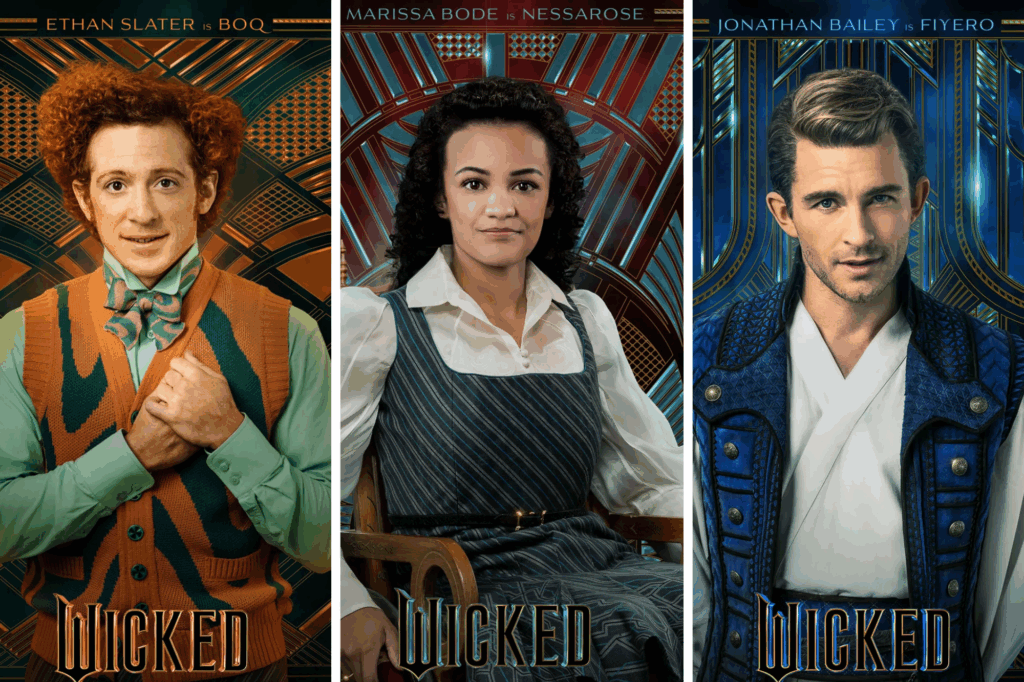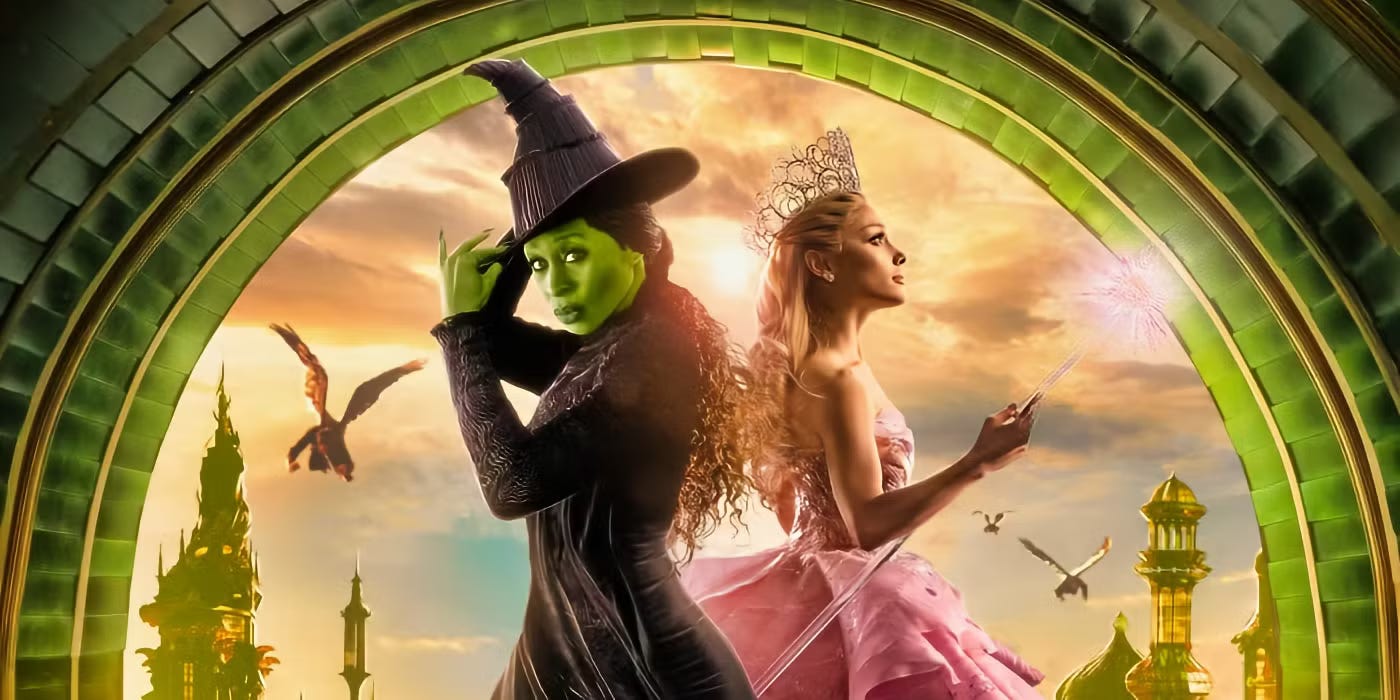Almost two decades after the musical Wicked enchanted Broadway audiences, Jon M. Chu’s Wicked (2024) lands on the big screen, supported by the combined star power of Cynthia Erivo and Ariana Grande, tasked with satisfying longtime fans while offering a fresh cinematic vision. Originating as Gregory Maguire’s 1995 novel, which reimagines the world of the 1939 film The Wizard of OZ, the narrative has been celebrated across mediums. Yet while the film captivates with breakthrough performances and stunning visuals, it struggles to deliver a fully satisfying cinematic experience alone, as narrative cohesion and resonance with the audience are compromised by the story’s division into two instalments.
Ahead of its release, director Chu, back in 2022, wrote on Twitter saying “…that it would be impossible to wrestle the story of ‘Wicked’ into a single film without doing some real damage to it.” He added that there would be “….not just one WICKED movie but TWO!!!”
While Chu framed the two-part approach as a deliberate choice to preserve the narrative’s integrity, watching the first instalment revealed that this decision also comes with significant compromises. As a standalone, Wicked (2024) struggles to provide a fully realised plot, as the narrative is disrupted, leaving key developments unresolved. Thus, much of the story hinges on the promise of an upcoming sequel.
Firstly, Wicked (2024), despite only being the first instalment of the adaptation, is 10 minutes longer than the blockbuster Broadway show in its entirety, with a runtime of 2 hours and 40 Minutes. Understandably, this caused some scepticism among netizens, with some concluding that it is a ‘bad decision’. Others find it puzzling how the story works within one musical production but can’t be contained in one film.
Bad decision. Just make one long movie. Like first movie is gonna end at Defying Gravity? 😬 You’re just gonna kill the momentum.
— Tyler Nakata (@TJNakata) April 26, 2022
there already is a wicked 2 and it’s THE WIZARD OF OZ!!!!!
— jaye (@hayejunt) April 26, 2022
However, those involved in the movie and some critics support the split, echoing Chu’s sentiment.
“[making it into a single movie] required us cutting or omitting things that we wanted to include and that we think fans of the show and the story will appreciate. Secondly, we found it very difficult to get past ‘Defying Gravity’ without a break.”
“I think there was talk: ‘Maybe we should just [squish] it together.’ ” But ultimately, the team decided to spread the story out. “There’s so many nuances.”
Some early critics even backtracked on their belief that a two-part release would inevitably fail. The overall consensus was that by dividing the story, the evolution and depth of Elphaba and Glinda’s friendship and their complex individual transformation can be explored without feeling rushed.
Moreover, it will enable the filmmakers to better immerse the audience in the intricate world of Oz, whilst also benefiting other characters with increased screentime.
I agree that Wicked effectively conveyed the magical and grand setting with a longer duration, allotting time for world-building and enabling the film to fully capture its expansive, intricately crafted set, making it a true visual spectacle.
Exclusive behind-the-scenes look at the creation of the Wicked universe
However, dedicating such a lengthy runtime to Act 1, postponing Act 2, weakens the storytelling by allowing for unnecessary plot points and resulting in seemingly underdeveloped characters. As noted in Barber’s BBC review, the film devotes valuable screentime to trivial and uneventful explanations, such as why Elphaba has a pointy hat or why the Yellow Brick Road is yellow, only for Glinda to justify it with a dismissive remark that “it just says road…”
‘Yellow Brick Road’ scene from Wicked (2024)
Similarly, characters like Boq, Nessarose, and Fiyero are given screen time to signal their importance. Yet, their actions in this instalment don’t substantially influence the central conflict between Elphaba, Glinda and the Wizard by the movie’s end. Without the developments reserved for Part Two (e.g Nessarose’s eventual rise as the Wicked Witch of the East), they feel incomplete and somewhat irrelevant, disrupting narrative cohesion.

Character posters from Wicked (2024): Boq, Nessarose, and Fiyero (left to right)
The sense of incompleteness is heightened by the fact that the Wicked (2024) concludes at Defying Gravity, which in the musical instead serves as a turning point for Elphaba. By ending with this sequence, the film converts a climax into a cliffhanger. In a standalone film, this approach to the ending undermines the essence of a self-contained narrative, making Part One feel more like an extended setup for the sequel than a nutritious story with its own dramatic arc.
And if you are like me, expecting to be emotionally moved by a complete narrative, misled by Universal’s marketing, which gave little indication that this is only Part One, the story’s division is particularly puzzling.
Returning to Defying Gravity, splitting the story across two films blunts its emotional impact as it promises a transformation but postpones the consequences. With the long interval between the two films, the weight of the characters’ choices will likely lose immediacy. Thus, the audience leaves the cinema, compelled to speculate what occurs next or, for those already familiar with the source material, how the upcoming event will be represented rather than reflecting on the story they had just watched. This delay in resolution hinders the audience from fully engaging with the emotional stakes, making the film less moving and thought-provoking.
Chu himself notes, “If Part 1 is about choices, Part 2 is about consequences”, a distinction made to justify two films. However, I would contest that this further demonstrates why the two films are inseparable, as the character decisions rarely come without consequences and inherently drive the narrative outcomes. The stakes associated with Elphaba’s boldness to rebel, juxtaposed with Glinda’s submission, only achieve their full significance once repercussions emerge, encouraging reflection on the cost of standing up for what is right and the blurred distinction between good and evil.
Ultimately, Wicked (2024) remains an entertaining movie with various embellishments, yet the two-part approach to storytelling compromises the narrative and its full emotional weight. With Part Two coming out later this year, audiences can only hope that it delivers the payoff that Part One, at a leisurely pace, merely teased. After all, as Glinda might say, Part One goes good with Part Two.
